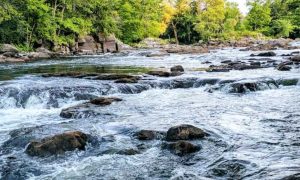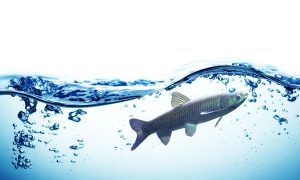Eutrophication
Is currently a leading problem in water management and affects directly many freshwater and coastal marine ecosystems in the world.
Why should we worry about eutrophication and how we can manage this problem?
One of the key sources of nutrient input identified is agriculture and irresponsible fertilizer management.
Management includes several important steps:
– responsible agriculture practices / fertilizes management
– waste water treatment
– monitoring
what happens
and how to understand
eutrofication better?
In agriculture production, fertilizers are widely used in excess, with a help of rain and ground water, the excess fertilizers/nutrients travel water sources and set-off a chain reaction in the eco-system.
Nutrients travel to lakes, rivers and oceans and here also, like they did before, feed the plants. This causes over abundance of algae and plant growth, eventually also enabling algae blooms. At this step the worst possible scenario is oxygen deprived waters (hypoxic) and the danger of decrease in the fish count (fish kill). As the algae grow, they tend to block the sunlight for the plants, causing them to die.
The plant matter eventually decomposes, and with the help of bacteria produce large amounts of carbon dioxide. This will cause lowering of the pH, a process known as acidification, and also oxygen deprivation.
In terms of the environmental problem, the effect is much bigger that the word itself (eutrophication).
We can expect many species going extinct due to lack of habitat and changes in water balance. In economic terms this leads to a reduced catch for commercial and recreational fisheries, meaning smaller harvests and more expensive food.
Here at HANNA Instruments, we are dedicated to environmental monitoring, and work through the monitoring of most important parameters.
Dissolved Oxygen
Dissolved oxygen control is critical in fish farming. It refers to the level of free, unbound oxygen in water or other liquids. This free oxygen is therefore not bound to any other element and provides information about the water quality, as it directly influences the living organisms in the water. In an aquaculture or a pond, the DO value should be between 5 and 12 mg/l (ppm). Among other things, it is essential for the photosynthesis of phytoplankton and is therefore the basis of a functioning food chain. An oxygen saturation of 60-70% is required for a healthy ecosystem and healthy fish. In general, most fish species will grow and thrive within a DO range of 5–12 mg/L (ppm). However, if levels drop below 4 mg/L some species may stop feeding, become stressed and begin to die. This series of events can start a chain reaction in a pond aquaculture system that could prove detrimental.
Oxygen depletion usually occurs in the summer months because warmer water holds less oxygen than cooler water. For example, water with a temperature of 32ºC can hold up to 7.3 mg/L of oxygen, while 7ºC water can hold 12.1 mg/L. As water temperatures rise, oxygen levels decrease. Higher temperatures also increase the metabolic rate of fish, resulting in the need for more oxygen in your fish farming operation.
How to measure dissolved oxygen?
Portable DO Meters
Portable meters provide the versatility to bring the meter to the sample. Hanna Instruments offer portable meters with the features and performance of a benchtop.
from hassle
OPTICAL!
HI98198 uses a luminescent optical method for the measurement of dissolved oxygen in water and wastewater.
- DO
- barometric
- pressure
- BOD
- temperature
The HI98198 is supplied complete with all accessories including probe, smartcap sensor with built in RFID, and a rugged carrying case.
Advantages: HI98198 Dissolved Oxygen Meter has many advantages over other Galvanic and Polarographic Dissolved Oxygen Meters. This meter uses HI764113 Rugged Optical Dissolved Oxygen Probe for Dissolved Oxygen measurement which has following benefits.
- No membranes
- No electrolytes
- No oxygen consumption
- No flow dependence or minimum flow rate
- Fast and stable readings
- Minimal maintenance
pH
Since fish live in water throughout their life cycle, it is necessary to constantly measure the pH.
When the pH value is somewhere between 4 to 5 there will be no reproductive cycle in fish.
Slow growth can occur if the pH value is between 4 to 6,5.
Desirable ranges for fish reproduction is from pH 6,5 to pH 9. If the pH value is between 9 to 10 slow growth of fishes will occur. pH value higher than 11 it comes to alkaline death.
For measuring pH you can use pH electrode from HI83303 or you can use Multiparameter Portable pH/EC/DO Waterproof Meter – HI98199.
The HI98199 is a rugged, portable multiparameter meter with a single digital probe input. The digital probe input allows the connection of either a pH, conductivity or dissolved oxygen probe. Between the three probes and a built-in barometric pressure transducer the HI98199 can measure up to 10 water quality parameters with 5 being measured by sensors and the other 5 by calculation (i.e. EC to TDS). This professional, waterproof meter complies to IP67 standards and is supplied with all necessary accessories to measure pH/temperature packaged into a durable carrying case.
How to make multiple measurements at once?
HANNA Multiparameter meters
HI98494
Portable pH/EC/D O Meter with Bluetooth
Functional and accurate, this meter is capable of testing 12 different water quality parameters using pH, EC, and optical DO sensors. Transfer data to a smart device for review or sharing with the integrated Bluetooth connection and Hanna Lab App.
- Waterproof ( meter rated IP67, probe rated IP68)
- Automatic interval logging of up to 45,000 samples or log-on-demand
- Perfect for environmental and industrial professionals.
- pH,
- ORP,
- EC conductivity,
- dissolved oxygen,
- turbidity,
- ammonium,
- chloride,
- nitrate,
- temperature
An optional GPS provides location tracking of measurements. The complete system is simple to setup and easy to use. The HI9829 is highly customizable and supplied with all necessary accessories, packaged in a durable carrying case.
Besides pH & D.O. there are other limiting parameters that are in close connection with eutrophication.
Vital parameters
Alkalinity plays a part in a dynamic relationship with pH and CO2 concentrations, high alkalinity water lowers fluctuations in pH. The buffering capacity acts to store extra CO2 essential for photosynthesis in the ponds to produce oxygen.
Maintaining calcium at certain levels is vital to proper fish growth and development.
Excessive nitrite can be toxic to fish. When nitrite interacts with hemoglobin the iron becomes oxidized and the blood cell can no longer carry oxygen.
Phosphate is essential to plant growth; too much phosphate in an aquaculture system can contribute to algal blooms decreasing dissolved oxygen vital for a successful ecosystem.
Present in water as a component of the nitrogen cycle, ammonia is excreted from animals and other organisms such as heterotrophic bacteria, actinomycetes, and fungi during the metabolism of proteins and amino acids. Generally present in small quantities in unpolluted waters, higher levels indicate organic pollution, and is toxic to aquatic life.
Easy way to measure critical parameters with HANNA photometers from our HI833XX family!
This meter has 20 different programmed methods measuring 12 key water quality parameters and also offers an absorbance measurement mode for performance verification and for users that would like to develop their own concentration versus absorbance curves.
Aquaculture parameters include alkalinity, calcium, nitrite, and phosphate which are critical to maintaining a healthy system. It also contains parameters specific to either a marine or freshwater environment. To save valuable laboratory benchtop space, the HI83303 doubles as a professional pH meter with its digital pH/temperature electrode input.
The benefit of this kind of analytical method is that can be applied with no major modification to the analysis of water on fish farms. Spectroscopy is promising tool to efficiently and cost-effectively obtain multiple types of fisheries data including fish physiological health and energetics that can provide indicators of environmental change. By these methods, all water parameters can be determined.
Customize your methods, take a wide range of measurements, and feel confident in your testing accuracy with iris.
The convenience of pre-programmed methods with the option to expand.
Parameters that are most commonly measured with HI801:
- Alkalinity
- Ammonia
- Calcium
- COD
- Copper
- Total Hardness
- Iron
- Nitrate
- Nitrite
- Total Nitrogen
- Dissolved Oxygen
- Phosphate
- Reactive Phosphorus
- Surfactants Anionic
Iris comes pre-programmed with more than 80 commonly used chemical analysis methods to help you get started. Simply update these methods by connecting to a computer or flash drive.
Nives Vinceković Budor, dipl. kem. ing.
Schindler, D. W. Recent advances in the understanding and management of eutrophication. Limnology and Oceanography 51, 356-363 (2006)
Smith, V. H. & Schindler, D. W. Eutrophication science: where do we go from here? Trends in Ecology and Evolution 24, 201-207 (2009).
https://earthhow.com/eutrophication-causes-process-examples/






